European regulation

The European initiative to reduce emissions to 55% in 2030
The European Commission announced in July 2021 a series of market measures in its package "Fit for 55", aimed at achieving the European Union's goal of reducing greenhouse gas emissions by 55% in 2030 compared to 1990 levels, in line with achieving European carbon neutrality in 2050.
This regulatory update focuses on the elements of this package related to the promotion of alternative fuels. All the pieces of legislation examined here can be modified by the European Parliament and the Council and must be approved by these two bodies before entering into force.
There are four proposals that will have the most impact on European, and indirectly international, maritime transport. Firstly, the European Commission proposes to tax marine fuels on intra-European trips in the new energy tax directive.
It is also proposed to expand the scope of application of the EU ETS to cover the maritime sector. This measure was already announced with the publication of the European Green Deal at the end of 2019. According to the proposal, the EU ETS will be expanded to include emissions from all ships over 5,000 gross tonnes, regardless of flag, operating in Europe , including routes into or out of the European maritime area.
The FuelEU Maritime regulation proposal introduces requirements to reduce the intensity of greenhouse gas emissions from marine fuels between 2025 and 2050. Like ReFuel EU for air transport, FuelEU Maritime is a regulation proposal that will be directly binding on ship operators. It applies to all energy used on ships in EU ports of call and on voyages between EU ports of call, as well as half of the energy used on voyages between an EU port and a third country. In addition, the FuelEU Maritime proposal introduces the additional requirement that, from 2030, ships must use power on shore for all their energy needs when at berth.
Fit for 55 also proposes to turn the Alternative Fuels Infrastructure Directive into a regulation (AFIR). The main changes related to renewable fuels are the introduction of mandatory deployment targets for electric recharging stations and hydrogen recharging stations for Member States.
01
ETD MARITIME
The Energy Tax Directive (ETD) has been harmonizing taxes on fuels and electricity in the European internal market since 2003. With the revision proposed in Fit for 55, the Directive will also regulate taxes on marine fuels.
02
AFIR
This initiative aims to ensure the availability and ease of use of a dense and widespread network of infrastructure for alternative fuels throughout the EU. All alternative fuel vehicle users (including ships and aircraft) should be able to move around the EU with ease, thanks to key infrastructures such as motorways, ports and airports.
03
EU ETS
The legislative proposal would include emissions from shipping in the current EU ETS. Emissions from the current ETS sectors (including the expansion to the maritime sector) should be reduced by 61 % by 2030, compared to 2005 levels, which is an increase of 18 percentage points from the current reduction level of 43 %
04
FUEL EU
New proposed European Regulation would impose a limit on the intensity of greenhouse gases ("GHGs") of the energy used on board by a ship arriving, staying or leaving ports under the jurisdiction of an EU Member State. It would also force the use of onshore power supply or zero-emission technology in EU ports.
05
RED III
European Directive on the promotion of the use of energy from renewable sources, which establishes the objectives of consumption of renewable energy and defines the sustainability criteria for the consideration of said energies as renewable, as well as the systems of guarantees of origin and certification of the themselves.
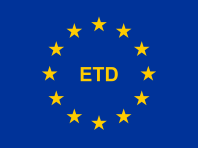
01
ENERGY TAX DIRECTIVE
With this directive, fuel usage in aviation, shipping (both shipping and fishing) and inland waterway transport will be taxed at the EU harmonized minimum rates for intra-community activities.
The standard is born with important challenges in its definition and execution. The risk of carbon leakage from fueling outside the EU is very high in the maritime sector. Ships, especially large ones, can cover long voyages with a single refueling and can carry additional fuel without significantly sacrificing carrying capacity. Ships carrying out transport operations outside the EU can avoid loading fuel in EU ports, as they can simply load more fuel in third countries and thus avoid the EU fuel tax.
On the other hand, to qualify for duty-free bunkering in the EU, ships would have to justify the need for tax-free fuel access. As an ex-ante condition, entitlement to duty-free fuel tax exemption would have to be demonstrated by submitting the relevant customs documents that indicate the next port of call outside the EU.
To further strengthen the application, vex-post erifications to strengthen the application, for example, in the positioning system of ships as part of random checks. The rules will be different for fishing vessels in which case there are no customs documents to examine.
LAST MINUTE: Finally, the Belgian presidency of the Council of Europe has not achieved consensus to process the proposal. See news.
5 keys about ETD
and marine fuels
1
Tax exemptions for marine fuels end, at least partially.
2
Fuels sold in the European Economic Area, for trips within the EEA, will no longer be exempt from taxes.
3
Heavy fuel oil and diesel will be taxed at a rate equivalent to around €37/t and LNG will also be taxed at a somewhat lower rate
4
Low-carbon fuels will have a 10-year exemption
5
International bunkers will continue to be exempt from taxes, although Member States have the option to impose them unilaterally, although this is not expected to happen
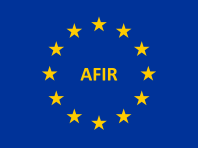
02
AFIR REGULATION
INFRASTRUCTURE ALTERNTIVE FUELS
This initiative aims to ensure the availability and ease of use of a dense and widespread network of infrastructure for alternative fuels throughout the EU. All alternative fuel vehicle users (including ships and aircraft) should be able to move around the EU with ease, thanks to key infrastructures such as motorways, ports and airports.
This proposal is part of the set of interrelated regulatory initiatives of the package «Fit for 55″. These initiatives correspond to the necessary actions in all sectors of the economy to complement national efforts to achieve the highest climate ambition for 2030. This initiative also acts in strong synergy with the proposal for a Regulation of the European Parliament and of the Council on the use of renewable and low-carbon fuels in maritime transport (initiative FuelEU Maritime), which establish obligations on the supply and demand of renewable and low-carbon fuels for transport.
Increasing the deployment and use of low-carbon and renewable fuels must be accompanied by the creation of a comprehensive network of recharging and refueling infrastructures based on geographic equity to enable the widespread adoption of low- and zero-emission vehicles in all modes of transport.
In the case of maritime transport, this initiative meets the clear requirement of the European Green Deal to oblige docked vessels to use electricity on shore (OPS). It is fully complementary to the EU's Fuel maritime initiative, as it ensures the installation of a sufficient shore power supply in ports to provide electricity while passenger ships (including ro-ro passenger ships, passenger ships high speed and cruise ships) and container ships are docked and to meet the demand for decarbonized gases (i.e. bioGNL and synthetic gaseous fuels (e-gas).
3 keys of AFIR
1
The Commission requires LNG and shore-side power supply facilities to be expanded in major EU ports, which is why it is reviewing the Alternative Fuels Infrastructure Directive, which will now become a regulation.
2
This review will require EU countries to make adequate investments in fuel supply, and make LNG available by 2025, as well as sufficient onshore power facilities by 2030.
3
The intent of this Regulation is to facilitate compliance with the shore power provisions of the FUEL EU regulation for maritime transport.
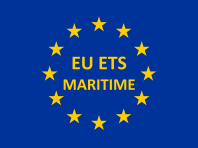
03
MARTIME EMISSIONS TRADING SYSTEM
EU ETS MARITIME
The legislative proposal would include emissions from shipping in the current EU ETS. Emissions from the current ETS sectors (including the expansion to the maritime sector) should be reduced by 61 % by 2030, compared to 2005 levels, an increase of 18 percentage points from the current reduction level of 43 %.
On July 14, as part of the package «Fit for 55«, the Commission adopted a legislative proposal for the revision of the EU Emissions Trading System (ETS), to align it with the objective of a reduction of 55% of the net greenhouse gas (GHG) emissions of the EU for 2030, compared to 1990 levels. This target is part of the European Climate Law (see separate file), and was set on the basis of the Commission's climate target plan that was presented on 17 September 2020.
The EU ETS was launched in 2005 and covers around 45% of the EU's greenhouse gas emissions. The latest revision of the EU ETS Directive, adopted in 2018, sets the total amount of allowances for phase 4 (2021-2030), in line with the previous EU emissions reduction target (reduction of 40 % below 1990 levels by 2030).
The legislative proposal would include emissions from shipping in the current EU ETS. Emissions from the current ETS sectors (including the expansion to the maritime sector) should be reduced by 61 % by 2030, compared to 2005 levels, an increase of 18 percentage points from the current reduction level of 43 %.
1O keys of the
EU ETS MARITIME
1
The EU ETS system, which limits European (EUA) CO2 emission rights, has worked for many industries and now shipping will join the system
2
The number of EUAs issued and the market mechanism determine their price. As the US decreases year after year, the market price will tend to increase, if the demand does not decrease fast enough.
3
Currently (September 2021) EUAs are trading at € 60 / t, which is equivalent to an increase of € 200 / t in the price of conventional marine fuel.
4
The ETS is based on the existing MRV reporting system. It applies to all ships, of any flag, with more than 5,000 GT carrying out commercial activities in Europe.
5
The entry of the maritime sector into the system will be done gradually. As of 2023, with 20% of total emissions, progressively increasing to 100% as of 2026
6
Ships are responsible for 100% of their CO2 emissions in EU ports and navigating between them, and 50% when entering or leaving the EU.
7
It only applies to CO2 emissions between the tank and the wake (T2W), upstream emissions or any other type of emissions, for example methane, are not considered. In this respect it differs from FUEL EU.
8
It is not a pay-per-use system. The operators are obliged to deliver the emission rights of the previous year before April 30 of the following year.
9
Holders are free to purchase EUAs on the market, at annual EU auctions or from other shipowners. Trading, hedging and speculation in emission rights is anticipated.
10
Failure to comply is costly, in addition to delivering the necessary EUAs, a penalty of €100/t will be imposed. Two consecutive years of non-compliance can lead to the ship being banned from EU waters
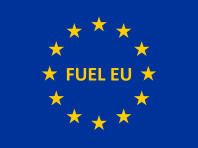
04
FUEL EU MARITIME
New proposed European Regulation would impose a limit on the intensity of greenhouse gases ("GHGs") of the energy used on board by a ship arriving, staying or leaving ports under the jurisdiction of an EU Member State. It would also force the use of onshore power supply or zero-emission technology in EU ports.
Greenhouse gas (GHG) emissions from ships were not included in the 2015 Paris Climate Agreement. In 2018, the International Maritime Organization (IMO), the United Nations body that regulates international shipping, adopted an Initial GHG Strategy for international shipping. It seeks to reduce GHG emissions from international shipping and phase them out as soon as possible in this century. The goal is to reduce average carbon intensity (CO2 per ton-mile) by at least 40% by 2030 and by 70% by 2050, as well as reduce total emissions by at least 50% by 2050, compared to 2008.
The IMO reduction target by 2030 can be achieved with available technology, through a combination of short- and medium-term measures, including operational measures such as reducing speed, improving operational efficiency through data analysis, limited use of low carbon fuels and energy efficient designs. The initial strategy includes a list of candidate measures in the short, medium and long term, to be agreed in the IMO's Marine Environment Protection Committee (MEPC) before 2023, between 2023 and 2030, and after 2030.
However, to meet the demands of 2050, shipping has to undergo a global transition towards alternative fuels and energy sources. All alternative fuels known today have certain limitations, many solutions are not yet mature and there is no obvious 'one fuel' option for the world fleet. Decarbonization will require great efforts, investments and time. The industry also notes that, with the current state of IMO regulations, the 2050 targets will not be met.
1O keys to understand
FUEL EU MARITIME
1
Its main objective is to drive the adoption of low-carbon fuels by imposing requirements on the greenhouse gas intensity of energy used on board ships. Requirements increase over time.
2
Unlike the EU ETS, this regulation uses a life cycle perspective (from well to wake) when determining CO2 equivalence, in addition to including methane and nitrous oxides.
3
The regulation will take effect in 2025 with a modest 2% upgrade compared to the 2020 baseline, and will increase to a 6% requirement in 2030. By 2050, the requirement will have become a 75% upgrade.
4
Since the regulations focus on the GHG intensity of onboard energy use, credit is given to systems that contribute energy, such as solar and wind. However, with the way calculations are currently done, conventional energy saving devices that simply reduce fuel consumption would not help comply with the regulations.
5
The scope of energy use covered by FUEL EU maritime parallels the approach taken for the EU ETS in that all energy used in or between EU ports is included, while only covers 50% of the energy used when entering or leaving EU ports.
6
The regulation offers tables with reference values for the equivalent carbon intensity of conventional fuels, both "upstream" and in on-board combustion. For new low-carbon fuels, or new propulsion systems, measurements supported by accredited entities are accepted.
7
It is also intended to establish a monitoring, notification and verification system that supports the regulation and that is proposed to be independent and additional to the current MRV system.
8
To add some flexibility, the system also includes an averaging mechanism over time and grouping for vessels and companies.
9
The regulation also includes shore power supply requirements for container and passenger ships; by 2030, these ships will need to be connected to power on shore when in EU ports for more than two hours.
10
Finally, as in the case of the EU ETS, there are penalties for non-compliance, including the possibility of being banned from entering EU waters if there have been two consecutive years of non-compliance. There is also a subsequent mechanism for failure to connect to electrical power on shore.
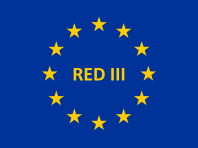
05
Renewable Energy Directive (RED III)
The Directive 2009/28 / EC, of the European Parliament and of the Council of April 23, 2009, regarding the promotion of the use of energy from renewable sources and by which Directives 2001/77/CE and 2003/30/CE are modified and repealed, establishes a common framework for the promotion of energy from renewable sources. It sets binding national targets for the share of energy from renewable sources in gross final energy consumption and for the share of energy from renewable sources in transport. It establishes rules relating to statistical transfers between Member States, joint projects between Member States and with third countries, guarantees of origin, administrative procedures, information and training, and access to the electricity grid for energy from renewable sources. renewable. And it defines sustainability criteria for biofuels and bioliquids.
These requirements were transposed into the Spanish legal system by means of Royal Decree 1597/2011, of November 4, which regulates the sustainability criteria for biofuels and bioliquids, the National Sustainability Verification System and the double value of some biofuels for the purposes of its computation. The directive is reviewed and updated in 2018 (RED II) with the aim of adapting it to the Paris Agreement and the new, much more ambitious decarbonisation goals.
Currently, as a result of the implementation of the Fit for 55 package, the directive is being updated (RED III) with the objectives of promoting the development of renewable energies in non-electrifiable uses and adapting the fuel sustainability criteria and objectives of national decarbonization to a model that considers the real carbon footprint of these products, taking into consideration the entire life cycle.
RED III Upgrade Keys
1
The national objectives for the consumption of renewable fuels are now measured in carbon intensity and maritime transport is included. RED II established minimum percentages of renewable fuel in road and air transport, without considering the different decarbonizing potential of each alternative fuel. Once the revision of the directive comes into force, the renewable fuel objectives will be measured based on the carbon footprint and maritime and air transport will be included.
2
More restrictive sustainability criteria. The consideration of a fuel as sustainable and the recognition of its reduction in greenhouse gases will be subject to more restrictive regulations, which could make liquid biofuels significantly more expensive.
In relation to maritime transport, they are defined by what fuels are considered alternative and what decarbonizing potential they have in order to be considered in the FuelEU regulation.
3
Certification and traceability of renewable fuels. The injection of bio and electro fuels into the network, the mixture of fuels with different degrees of decarbonization and the compatibility of consumption equipment are necessary mechanisms to carry out the energy transition and require a flexible certification system of origin that is recognized throughout the EU .
ACCESS TO DOCUMENTS
Continue ...
Continue ...
Continue ...
Continue ...





